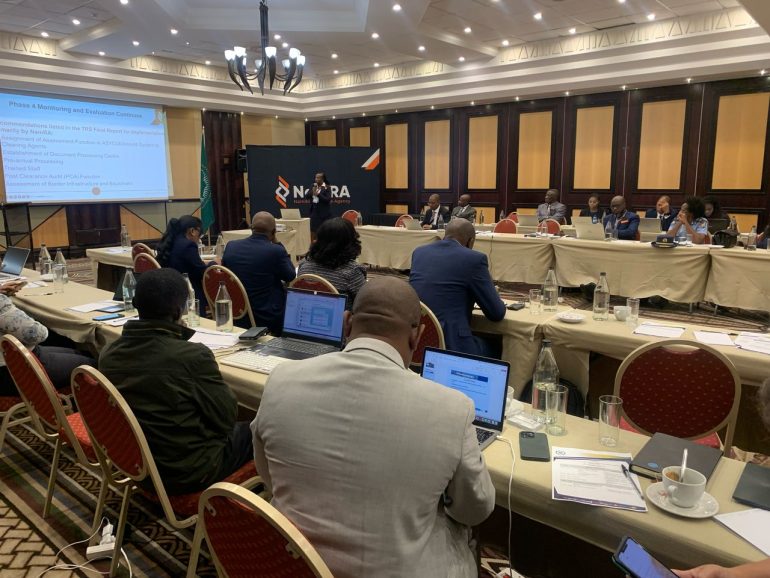Omanyano ovanhu koikundaneki yomalungula kashili paveta, Commisiner Sakaria takunghilile
Veronika Haulenga
Omanyano ovanhu koikundaneki yomalungula kashili paveta, Commisiner Sakaria takunghilile
Veronika Haulenga
Listeners:
Top listeners:
-
play_arrow
Omanyano ovanhu koikundaneki yomalungula kashili paveta, Commisiner Sakaria takunghilile Veronika Haulenga
Burkina Faso, Mali and Niger hint at a new west African currency: what it’ll take for it to succeed


By Thierno Thioune, Université Cheikh Anta Diop de Dakar
On 11 February 2024, the head of Niger’s ruling military junta, General Abdourahmane Tiani, spoke of the possible creation of a common currency with Burkina Faso and Mali. “The currency is a first step toward breaking free from the legacy of colonisation,” he said on national TV, referring to the CFA franc inherited from French colonisation.
Burkina Faso, Niger and Mali, three former French colonies, have experienced military coups in recent years. They’re now all ruled by military regimes. They also formed a new defence alliance, known as the Alliance of Sahel States (AES).
The Economic Community of West African States (Ecowas) has condemned these coups and imposed sanctions on the countries involved. In response, these countries decided to withdraw from Ecowas. However, they remain members of the West African Economic and Monetary Union (Uemoa). Uemoa has a common currency, the CFA franc, which is issued by the Central Bank of West African States (BCEAO).
The BCEAO and the Banque de France are bound by cooperation agreements that include the deposit of a portion of foreign exchange reserves at the Banque de France and France guaranteeing the CFA franc.
Thierno Thioune, an expert on monetary policies and unions between west African states, analyses the potential implications and feasibility of launching a new currency for the AES member countries.
What conditions must be met for a multilateral currency to work?
To successfully launch and maintain a multilateral currency, several key factors must be considered.
First, macroeconomic and budgetary policies must be closely coordinated. Rigorous harmonisation of economic and budgetary policies between participating countries is imperative to guarantee the stability of the currency’s value and prevent trade imbalances. This will help maintain the confidence of economic players and promote regional growth.
Second, robust monetary management institutions must be established. Strong institutions responsible for currency management, like a common central bank, are essential. This central bank must have adequate authority to implement an independent and stable monetary policy. This will ensure the preservation of the currency’s value and address cyclical fluctuations.
Third, creating an integrated common market is vital. The unrestricted flow of goods, services, capital and labour is key to driving economic growth and enhancing regional cooperation. The current framework provided by the West African Economic and Monetary Union offers a significant advantage in this regard.
Finally, mechanisms to monitor and resolve crises need to be established. For instance, common reserve funds and currency swap arrangements could help address external and internal shocks that may affect the new currency. Currency swaps – when two parties exchange amounts in two different currencies for a certain period at a fixed rate – can be used to manage exchange rate risks and facilitate cross-border financing.
Are these conditions met in Burkina Faso, Niger and Mali?
It’s difficult to say whether these conditions have been fully met in the three countries. It would mean having a firm understanding of whether these, among other, conditions have been met:
- harmonisation of government policies
- macroeconomic stability through inflation control
- limit on public debt
- maintenance of a balanced current account.
At this time, it’s hard to say whether these countries have done this.
Does their monetary union membership make any difference?
These three countries have been part of the West African Economic and Monetary Union since 1963. In theory, this should give them some experience in coordinating economic and monetary policies through the CFA franc.
They could have experience with infrastructure, like the Central Bank of West African States (which manages the single currency and monetary policy for member states), that would help them with the transition.
What are the potential gains and risks of the initiative?
Despite the risks involved, the initiative could bring several benefits.
Establishing a larger monetary zone can foster greater trade integration and improved resource allocation.
It could enhance the country’s “flexibility” in dealing with external partners.
By joining a new monetary union, these three countries could also benefit significantly from increased trade integration, independence from external partners, lower transaction costs and investor attractiveness.
Nevertheless, this initiative also entails risks, particularly with regard to their position within the West African Economic and Monetary Union and Ecowas. The latter could perceive the creation of a new currency as a threat to their regional influence. It could cause the fragmentation of existing economic blocs. In addition, the departure of the three countries could weaken the solidity of the West African Economic and Monetary Union and Ecowas in terms of economic and political influence.
There are also risks that the currency could quickly lose value.
The new currency could depreciate against the CFA franc. This could have substantial negative repercussions for exporters to other West African Economic and Monetary Union countries.
Second, without proper formal frameworks to control and manage the new currency, speculation and uncertainty regarding its value may emerge. This is why establishing robust institutions to support the management and supervision of the new currency is crucial.
How will the new currency affect trade in the zone?
The creation of a new currency by these three nations could, temporarily, have a negative impact on their trade with countries within the current bloc. It could even lead to some turbulence in trade with countries outside it.
The transition to a new currency typically introduces a level of uncertainty among economic actors and trading partners, as questions arise about the currency’s value, convertibility and stability. This adjustment phase can lead to a temporary slowdown in trade.
In addition, the introduction of a new currency often requires legislative and regulatory changes, especially regarding foreign exchange operations and customs duties. These can act as administrative and regulatory barriers and result in delays in commercial transactions.
During the transitional period, there may be fluctuations in exchange rates. This will lead to disparities between the old and new currencies. It can affect price competitiveness between exporters and importers and reduce the overall volume of trade.
The perceptions and attitudes of external partners matter when a new currency is announced. Some trading partners may exhibit reluctance or express doubts regarding its reliability and credibility. This could diminish their willingness to continue trading with member countries of the zone.
Could the move isolate them?
The creation of a new currency by these three countries may indeed raise questions about their potential isolation. However, such an initiative should not automatically lead to a diplomatic rupture or total marginalisation.
To avoid this, proactive communication, constructive cooperation and balanced, inclusive regional economic integration are key. This will help mitigate the risks of isolation for Burkina Faso, Mali and Niger in their monetary project.![]()
Thierno Thioune, enseignant-chercheur, directeur du CREA, Université Cheikh Anta Diop de Dakar
This article is republished from The Conversation under a Creative Commons license. Read the original article.
Written by: Contributed
Burkina Faso Central Bank CFA franc currency economic blocs economic integration exchange rate Fiscal Policy Inflation macroeconomic stability Mali Monetary Policy monetary union Niger Regional Cooperation trade West Africa
Similar posts
Windhoek Weather
Most popular

Namdia Heist: More questions, lots of confusion

Omuhwahwameki Michael okuunganeka oshikonga shoku patitha oostola dho Rani moshilongo ashihe.

Walvis Bay woman loses over N$777.000 to a fraudster

Don’t let Pohamba’s tears over Nujoma’s death go to waste

Justice Served: Jandre Dippenaar Found Guilty of Six Murders in Swakopmund Court
Copyright 2025 Future Media (Pty) Ltd | Website by Digital Platforms
Tel: +264 83 000 1000 | Email: news@futuremedia.com.na





